Winter Blooms
The Garden’s two conservatories, the Orangerie and the Limonaia, display 300 to 500 plants. The current collection represents species found on every continent, except Antarctica. It includes plants with rare qualities, plants on the IUCN Red List for threatened species, and plants that are so old, phylogenetically speaking, that their genetic makeup has remained unchanged since the time of the dinosaurs. In the cold months, the collection stays in the conservatories’ warm temperatures, an assortment of plants blooming throughout December, January, and February.
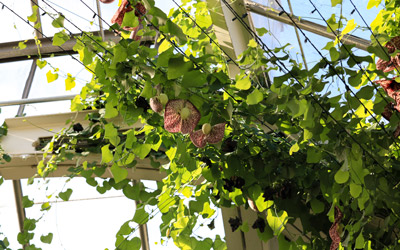
Giant Dutchman’s pipe (Aristilochia gigantea)
Cut back each summer, the giant Dutchman’s pipe can grow anywhere from 15-20 feet a season. This fast-growing vine produces light green leaves and large burgundy flowers that are marked with distinct ivory-colored veins. In its native range — the humid forest areas of Costa Rice, Panama, and Brazil — the vine will flower from summer to winter. In the Orangerie, the plant will often bloom multiple times throughout the year.
Location(s): The Orangerie

Hibiscus (Hibiscus rosa-sinensis)
The Hibiscus genus contains several hundred species. This iconic species of hibiscus, commonly called tropical hibiscus, is native to Southeast Asia. The vibrant coloring of its large, showy flowers follows that of other hibiscus blooms. The cultivar found in the Orangerie (‘Midnight Tryst’) boasts blooms that have a red center, and purple to orange-yellow coloring along the outer edges of the petals.
Location: The Orangerie
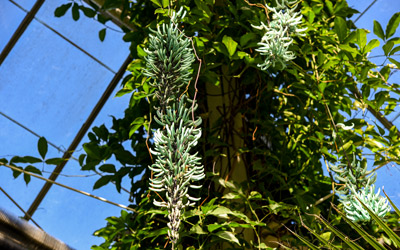
Jade vine (Strongylodon macrobotrys)
Jade vines are known for their unique jade–colored, claw-shaped flowers which bloom in large, showy clusters that can be as long as 40 inches. The perennial woody vines can grow upwards of 50 feet and are native to tropical rainforests in the Philippines. In their native habitat, jade vine flowers are pollinated by bats. The Garden’s jade vine typically blooms multiple times a year.
Location: The Orangerie
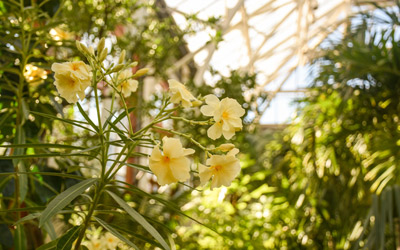
Oleander (Nerium oleander)
Commonly called by its botanical name, this upright shrub is valued for its abundant, fragrant flowers. Blooms of an oleander can be shades of purple, pink, yellow, or white. The flowers are five-petaled and funnel-shaped. Don’t be fooled by the beauty of an oleander. All parts of this plant are considered poisonous if ingested and should be handled with care by those who have one at home.
Location(s): The Orangerie
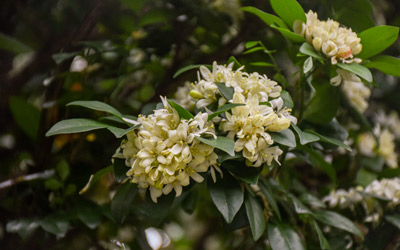
Orange jasmine (Murraya paniculata ‘Lakeside’)
When in bloom, these trees are hard to ignore. Their clusters of white flowers offer a stunning fragrance that fills whatever space they may occupy. Their native range stretches across China, India, and Australia. These small trees can grow as tall as 20 feet and are often noted for their glossy evergreen leaves. The Garden’s orange jasmine will bloom a few times throughout the year, often when inside the Orangerie.
Location(s): The Orangerie
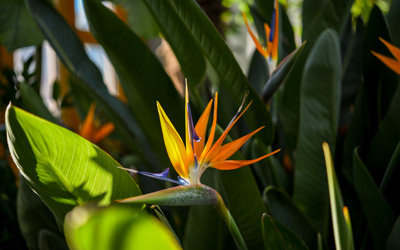
Bird of paradise flower (Strelitzia reginae)
These herbaceous perennials are some of the most well-known plants in the world because of their iconic flowers. They are native to South America but have been cultivated worldwide. Their flowers, shaped like the head of a crane, consist of three bright orange sepals and three vibrant blue petals. In the right conditions, bird of paradise plants can bloom year-round, the flowers lasting for up to two weeks at a time.
Location(s): The Orangerie

Camellia (Camellia spp. and cultivars)
Native to China and Southeast Asia, camellias are a diverse plant group with over 250 known species. Of the Garden’s collection, many of these beautifully blooming shrubs are Camellia japonica, a species native to Japan. These camellias are especially beloved for their flowers — scentless, many-petaled blooms that are commonly white, pink, or red. The collection blooms while overwintering in the Limonaia.
Location(s): The Limonaia
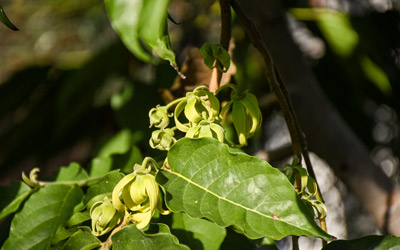
Ylang-ylang tree (Cananga odorata)
The ylang-ylang is a South Asian tree of the custard apple family Annonaceae. The flowers of a ylang-ylang are simple, featuring six narrow, greenish-yellow petals. These trees have intensely fragrant flowers often used in perfumes, most notably Chanel No. 5. Ylang-ylang trees are slender and have smooth bark, often reaching around 80 feet when full-grown.
Location(s): The Orangerie
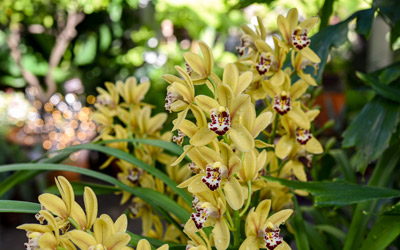
Orchids (Orchidaceae family)
The orchid family — Orchidaceae — is one of the oldest, largest, and most diverse families of flowering plants. With over 28,000 known species and more than 700 recognized genera, orchids are found on all continents (except for Antarctica.) North America is home to over 200 of these species and about 45 can be found in Massachusetts. The Garden’s “tropical” collection of orchids includes several different species and varieties such as slipper orchids (Paphiopedilium), moth orchids (Phalaenopsis), and boat orchids (Cymbidium).
Location(s): The Orangerie and Limonaia
